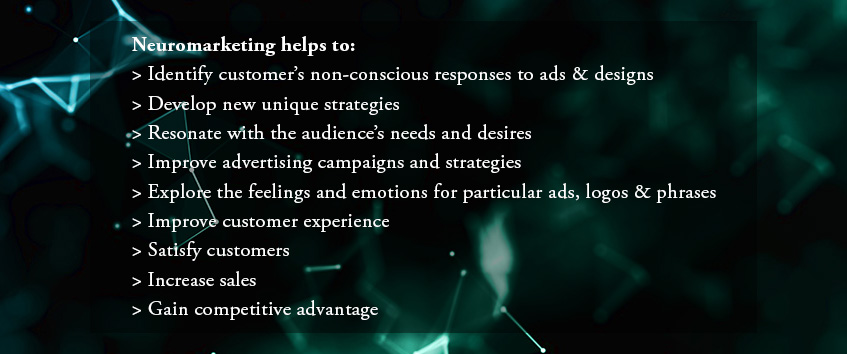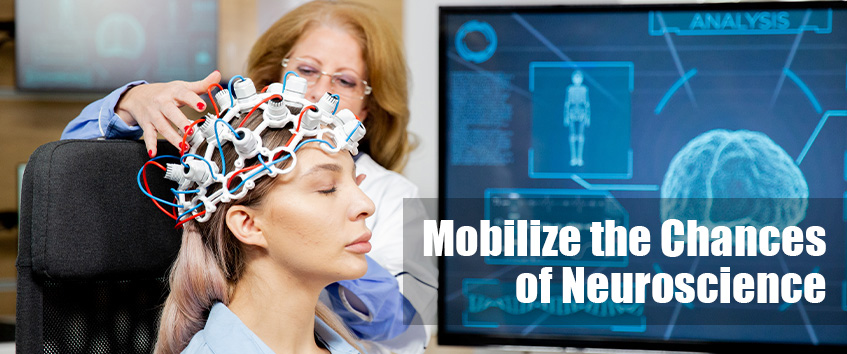Neuromarketing-Decoding the Mind of Consumers
June 15, 2023
We as consumers make decisions every day, but have you ever wondered how that happens? On what basis do we choose each and every item for the needs of our daily life? On the basis of price, on the basis of brand, on the basis of beauty?
What do we pay attention to, and do our initial reactions predict our final choices? Do you realize how important our senses are to our shopping experiences?
Let’s think about all these now on the basis of Neuromarketing. In this blog, let’s delve into the core principles and strategies behind Neuromarketing, and how businesses can leverage these insights to create effective and impactful marketing campaigns. Get ready to unlock the secrets of the human mind and discover the transformative potential of Neuromarketing!
Neuromarketing- Decoding the Mind of Consumers: A Brief Overview
The term “Neuromarketing” is used informally to describe the monitoring of physiological and brain signals to gather knowledge about human motives, preferences, and decisions. This knowledge can then be used to improve product development, pricing, and other marketing strategies. The two most popular techniques for measuring are brain scanning, which measures neural activity, and physiological tracking, which monitors eye movement and other proxies for that activity.

When we explain this from the perspective of marketing, neuromarketing is a technique used to study how consumers’ brains react to commercials and how this influences their purchasing decisions. If you find this intriguing, we might want to think about working in this industry. We may find better success in our position by learning how marketing specialists might apply this strategy when creating a marketing plan for a business and how it might impact product sales. It’s also possible to use neuromarketing to try to manipulate consumer behavior. This action is useful to predict how a particular product, service or marketing campaign will perform.
When we look at the definition of neuromarketing- Decoding the Mind of Consumers from a scientific perspective, it reads as follows: Neuromarketing is a method of neuroscientific study used to address marketing issues. For instance, analyzing advertising efforts with EEG or fMRI. And from there it got the name neuroscience. However, neuromarketing is not entirely covered by neuro research.
Why do Neuromarketing?
Making choices was once simple. But consumers are bombarded with information today. Even the most basic things float aimlessly in a sea of options. For instance, there are several brands of products available worldwide. The market for products assumes Interbrand uniformity, which causes a lot of misunderstanding because a useless product can only have so much variation. So what motivates customers to choose one brand over another? Actually, there isn’t a simple solution. It might be the product’s labeling, shelving, personal product experience, brand reputation, or any combination of these factors.
We can reap even more benefits through Neuromarketing…

Making a logical purchase amidst the sea of possibilities is more than challenging, it is impossible. Almost any product can be used to apply this rule. As a result, customers make the majority of their decisions without using conscious thought. However, the bulk of marketers still carry out their market research using conventional methods. Why would we rely on what consumers say to guide our marketing and advertising efforts if we assume that they are unable to consciously explain the reasons behind their purchasing decisions? Simply said, neuromarketing is the only method for gathering data from the subconscious, the origin of human decision-making. And how does it operate? We’ll see.
Neuromarketing Instruments
As “Neuromarketing” loosely refers to the measurement of physiological and neural signals to gain insight into customer’s likes and dislikes. The two primary Neuroscientific techniques applied to business and advertising of Neuromarketing are:-
- Techniques that register psychological activities
- Techniques that register behavior and conduct
Brain scanning, which measures neural activity, and physiological tracking, which measures eye movement and other proxies for that activity, implicit response tests are the most common methods to register psychological activities of human beings.
Implicit Response Test, Indoor positioning techniques, Usage of Beacons and cameras in daily life are the ones that catch up the behavior and conduct by the neuromarketing.

Logical methods that are frequently used in conventional neuromarketing research includes deep interviews, focus groups, and surveys. These direct research methods concentrate on examining the consumer’s behavior, whether it is directly displayed or spoken. However, it is highly likely that the answers provided by the participant are biased or skewed, whether intentionally or unintentionally, as a result of the influence of stereotypes, cognitive biases, emotions, social and moral norms, or just because he or she is unable to express his or her feelings, thoughts, and what drives the purchase decision.
Benefits of Neuromarketing
The multifaceted nature of neuromarketing often leads to uncertainty about its practical applications within existing business operations. The challenge lies in providing clear and precise explanations of how neuromarketing can be effectively integrated. However, this flexibility is also its greatest advantage. In reality, neuromarketing can address a wide range of research inquiries pertaining to products, even surpassing the limitations of traditional marketing research methods.
Professionals can use neuromarketing to better understand what drives customers to choose one brand over another when buying a certain product. Professionals who use this marketing strategy can learn more about consumer preferences and decision-making processes. Using customer preferences and motivations, marketers can utilize neuromarketing to forecast how effectively a product, service, or brand may appeal to or sell to people.

It may be advantageous for a brand to invest in neuromarketing because it enables them to increase lead generation, enhance marketing and advertising strategies, and grow their brand. Because the brand is aware of what people want and how they make decisions, these advantages are possible. The following are some benefits of employing this marketing strategy for a business:
- A deeper understanding of the target market
To learn how consumers respond to a brand’s numerous products and advertisements, marketers can utilize a variety of tools and technology. They can find out from the brand what the customer dislikes. Consumer-friendly commercials and messages can be developed by reworking the company’s marketing plan if it is a common subject among customers. Additionally, it might provide a business an edge over rivals who might not employ this tactic.
- Using psychological variables to enhance content
An individual’s motivation, perception, education, attitudes, and beliefs are examples of psychological elements. The variables can elicit feelings or reactions in people and have an impact on how they act or think. In neuromarketing, marketers can make better use of psychological components to enhance company content and appeal to consumers’ shared physiological aspects.

- Adding to a company’s financial worth
By using neuromarketing, marketers can produce advertisements for goods and services that appeal to consumers, increasing the financial value for a company. Once they know what customers want from a company’s goods or services or which kind of advertising strategies are more effective than others, they can boost sales. The more a business comprehends its target market and the psychological factors that influence consumer purchasing decisions, the more it can use that knowledge to increase customer satisfaction and financial success.
What Makes Neuromarketing So Significant?
Despite its controversy, neuromarketing is still crucial for businesses. It includes several methods that allow brands to comprehend and satisfy consumer wants and preferences. Additionally, they can research how different commercials, campaigns, and product packaging affect consumer behavior. As a consequence, business owners can select the best choice from all available options and increase the efficacy of campaigns and plans.

We can benefit from neuromarketing in additional ways besides the ones already discussed. It aids in developing new, original strategies, resonating with audience needs and desires, improving advertising campaigns and strategies, exploring the feelings and emotions about specific ads, logos, and phrases, improving customer experience, and satisfying customers to increase sales gain, and this kind of marketing techniques also gives competitive advantages too.
Several Concerns Within Neuromarketing
So far we have come across the positive aspects of this sophisticated technique called neuromarketing. Now look at the concerns about these? It revolves around several key areas that raise ethical, practical, and methodological considerations. Let’s go through that as well.
1. Moral Considerations
It is an age-old query. Some people believe that neuromarketing manipulates consumer’s minds. Neuromarketing carries out tasks that a skilled psychologist would carry out. It only “learns” your patterns of behavior and generates intelligent results.
2. The Accessibility of Particular Skills
The higher quality of insights you can achieve depends on how much particular knowledge you have. A long time ago, in order to read the waves and graphs that neuro-tools you should have a background in science. Since the reports are now simpler to interpret (due to technology), it is no longer necessary. However, you will still need to work on understanding what these data, statistics, and heat maps imply. We must lend a hand with science to apply this neuromarketing.

3. Expensive Apparatus
It’s true that neuromarketing tools have always been pricey. Electroencephalogram (EEG in neuromarketing), Functional Magnetic Resonance (fRMI in neuromarketing), Magnetoencephalography (MEG in neuromarketing) are some of them. While this is often a significant amount for a large business sector or a well-known brand, for a small business, it can be considered extraordinary and there is no guarantee that the quality of data available with such expensive means and equipment will be as good as it was ten years ago.
4. Security
With widespread interest in neuroscience tools, it is clear that individuals need more control over the information they disclose. Well, no one is truly immune to data breaches. We must therefore strive to advance data protection technology and procedures. The information we get with the help of neurotools is not just data. An incentive to increase customer satisfaction through improvements to the product and buying experience is highly unlikely to be classified as illegal. In any case, be prepared to continue to believe that efforts to penetrate consumer’s minds violate their right to privacy and personal existence.
What Does the Future Hold for Neuromarketing?

On the whole, the field of neuromarketing is still in its infancy. Since many of the businesses operating in this field are lagging behind, it is challenging for industry leaders to build their credibility. Neuromarketing will continue to show that it can have an extraordinary impact on marketing efforts and produce a higher return on investment than any other type of market research as the field develops and technology advances. Marketers must decide which neuromarketing firms are worthwhile investments until the rest of the world catches up.
Applying Neuromarketing Principles in Digital Marketing
We should realize that understanding the inner workings of the human brain can significantly impact the effectiveness of your digital marketing efforts. Here’s how we can incorporate and leverage neuromarketing into our digital marketing strategy.
In today’s digital landscape, cutting through the noise and making our brand shine amidst countless stimuli is no small feat, which is precisely where Neuromarketing comes into play. Employing neuromarketing techniques is now crucial to optimize our digital strategy and achieve superior outcomes in our daily marketing endeavors.
At its core, neuromarketing enables digital marketers to create conversion pathways that align with consumer’s cognitive characteristics, guiding them toward specific purchasing decisions. This involves optimizing various elements such as text, images, videos, design, interactive elements, applications, and understanding touchpoints that direct potential customers.

One fundamental consideration for marketers is ensuring that the primary call-to-action is easily communicated through imagery. An eye-catching image is the first thing consumers notice in a digital advertisement. Engaging content generates experiences in people’s minds that can profoundly influence their attitudes.
Consumers gravitate towards brands that possess a distinct and authentic voice. Our audience perceives our brand as a personality with specific traits and characteristics. Brands lacking a distinctive voice struggle to connect with target audiences and subsequently lose their appeal in attracting leads.
Furthermore, consumers are driven more by the emotional value of a brand than any other factor. Research suggests that emotional connections have a greater influence on attracting leads than customer satisfaction.
This same philosophy applies to digital marketing, where emotional triggers hold more sway over consumers than any other factor. In particular, humor is a psychological element in marketing that consistently resonates. Everyone wants to associate with a brand that exudes a humorous personality.

Moreover, influencer marketing is currently one of the most impactful trends in digital marketing. Humans naturally tend to trust industry experts, placing great value on their advice and guidance. However, neuromarketing-Decoding the Mind of Consumers goes beyond understanding why consumers make purchases at specific times or in certain quantities; it’s about repeating and replicating that buying process to drive increased sales.
Here are some key insights on how to apply neuromarketing in our digital marketing strategies:
1. Social validation
2. Information
3. Storytelling
4. Client-centric approach
5. Pricing
6. Product display
7. Clear design
8. Giveaways
Understanding human behavior is crucial. Make your target audience’s digital experience memorable, innovative, adaptive, and leave a lasting impression. It would be great to realize and utilize the latest trends in neuromarketing to help your business stand out in today’s fierce competition.
Let Neuromarketing Empower Your Marketing Sphere
